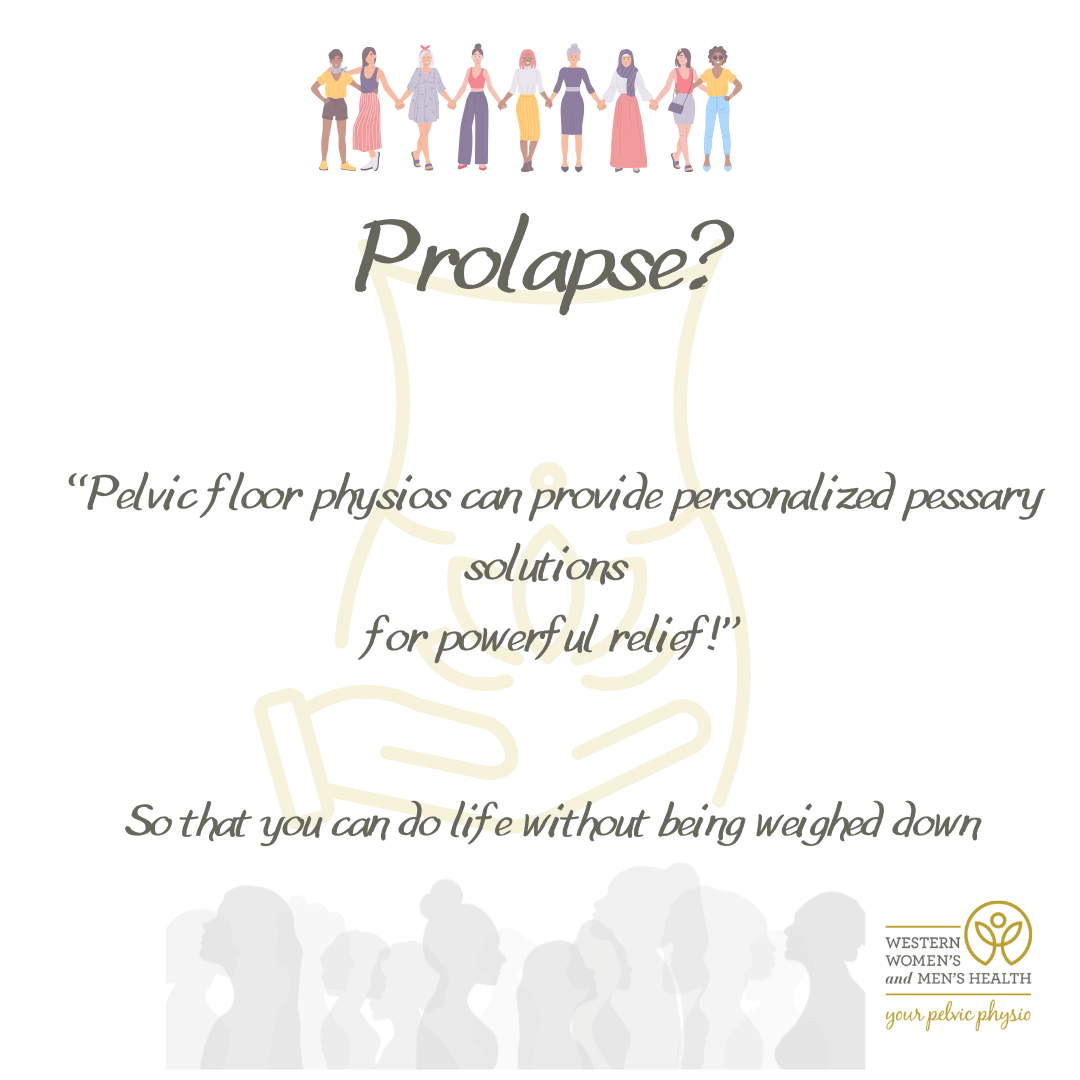
14 Jul Managing Pelvic Organ Prolapse with Pessaries and Physiotherapy: An In-Depth Guide for Women
Pelvic organ prolapse (POP) is a common yet often under-discussed condition affecting about 50% of women who have given birth vaginally, with around 10% of women needing surgery at some point due to prolapse symptoms or related issues. Although prolapse can impact daily life, many women manage their symptoms effectively with non-surgical options like pessaries and physiotherapy, which offer reliable alternatives to surgery in suitable cases.
Understanding Pelvic Organ Prolapse
Pelvic organ prolapse occurs when the pelvic floor muscles and connective tissues weaken, leading to the descent of pelvic organs—such as the bladder, uterus, or rectum—into the vaginal canal. Studies show that risk factors include childbirth, aging, obesity, and certain lifestyle factors, with nearly 20% of women aged 50 and older experiencing symptomatic prolapse.
Symptoms of Pelvic Organ Prolapse
Symptoms vary depending on the type and severity of prolapse but commonly include:
- Pelvic Pressure or Heaviness: A feeling of fullness or pressure in the pelvic area, especially after standing or physical activity.
- Visible or Palpable Bulge: In advanced prolapse, a bulge or mass may be felt or seen protruding from the vagina.
- Urinary Symptoms: Difficulty emptying the bladder, urinary leakage (particularly during physical activity or coughing), or frequent urination.
- Bowel Symptoms: Constipation, difficulty emptying the bowels, or a sensation of incomplete bowel evacuation.
- Discomfort During Sexual Activity: Many women report pain or discomfort during intercourse due to prolapse.
These symptoms can range from mild to severe and often worsen with prolonged standing, lifting, or high-impact activities.
Types of Prolapse
Each type of prolapse presents its own unique symptoms and requires specific treatment:
Cystocele (Bladder Prolapse): The bladder bulges into the front vaginal wall. This type of prolapse often results in urinary symptoms, and recent studies highlight that over 75% of women with cystocele experience stress urinary incontinence.
Rectocele (Rectal Prolapse): The rectum bulges into the back vaginal wall, leading to constipation and feelings of incomplete bowel emptying. Research shows that nearly 70% of women with rectocele have associated bowel symptoms.
Uterine Prolapse: The uterus may descend into the vaginal canal, causing pelvic pressure and discomfort. Studies show that uterine prolapse occurs in about 15-20% of women after childbirth, with severity increasing in post-menopausal women.
Enterocele (Small Bowel Prolapse): The small intestine may push into the vaginal canal, commonly following a hysterectomy. Enterocele is often accompanied by a sensation of pressure and discomfort.
Vaginal Vault Prolapse: After a hysterectomy, the top of the vaginal canal may descend. Approximately 10% of women who undergo a hysterectomy experience vaginal vault prolapse.
The Role of Pessaries in Managing Prolapse
Pessaries are medically designed devices that support the prolapsed organs and provide relief from symptoms without surgery. Studies suggest that nearly 77% of women report significant symptom improvement with pessary use, and 90% find a well-fitted pessary comfortable enough to wear daily.
Types of pessaries include:
Ring Pessary: Best suited for mild cystocele and uterine prolapse, providing comfortable support for everyday use.
Gellhorn Pessary: Provides firmer support for more advanced prolapse. Research shows it is effective in relieving pelvic pressure for women with higher-grade cystocele.
Cube Pessary: With multiple points of contact, the cube pessary is effective for advanced prolapse cases involving multiple prolapsed organs. A study found that 85% of women with multi-organ prolapse reported improved quality of life with the cube pessary.
Donut Pessary: Often used for severe prolapse, providing sturdy support across multiple organs.
Incontinence Dish Pessary: Specifically designed for prolapse and mild stress urinary incontinence, with studies showing a 70% reduction in urinary leakage when used consistently during physical activity.
Knob and Shatz Pessaries: These provide secure support for advanced uterine prolapse. They are ideal for women with severe uterine descent and are associated with a significant reduction in prolapse symptoms.
How Physiotherapy Supports Prolapse Management
Physiotherapy is vital in prolapse management, particularly in strengthening the pelvic floor to alleviate symptoms and improve overall support. Evidence suggests that pelvic floor muscle training (PFMT) can reduce prolapse symptoms by up to 42% when practised consistently. Here’s how physiotherapists support prolapse management:
Initial Assessment: The first appointment includes a review of symptoms, medical history, and a physical exam to assess prolapse type and muscle strength.
Pessary Fitting: When appropriate, pessaries are fitted to ensure comfort and effectiveness. A study in the International Urogynecology Journal found that a well-fitted pessary significantly reduces symptom burden for 70% of women.
Personalized Exercise Program: Pelvic floor exercises strengthen and support prolapsed organs. Research in the Journal of Physical Therapy Science reports that consistent PFMT improves prolapse symptoms in 80% of women, often reducing the severity of prolapse by one grade.
Lifestyle Modifications: Education on avoiding high intra-abdominal pressure activities and guidance on daily posture and lifting techniques are integral to reducing prolapse progression.
Follow-Up and Monitoring: Regular follow-up helps ensure the pessary remains comfortable and that progress is on track. Studies show that regular physiotherapy check-ins can help prolong the effectiveness of conservative management, with symptom improvement sustained for years in compliant patients.
Empowering You to Take Control of Prolapse Symptoms
Pelvic organ prolapse is manageable with informed, non-surgical strategies. Both pessary use and physiotherapy can reduce symptoms, empower daily function, and improve quality of life. By seeking support from a trained pelvic floor physiotherapist, you can take control of prolapse symptoms and embrace a more comfortable, active lifestyle.
If you’re concerned that pelvic organ prolapse is impacting your daily life, make an appointment to see one of our experienced pelvic floor physios.
